To help us provide you with free impartial advice, we may earn a commission if you buy through links on our site. Learn more
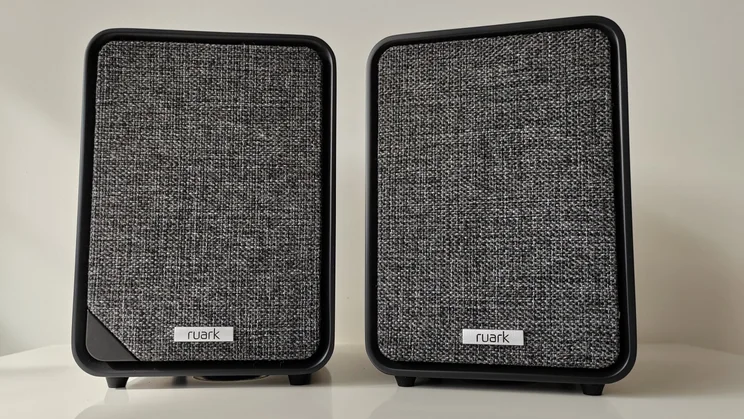
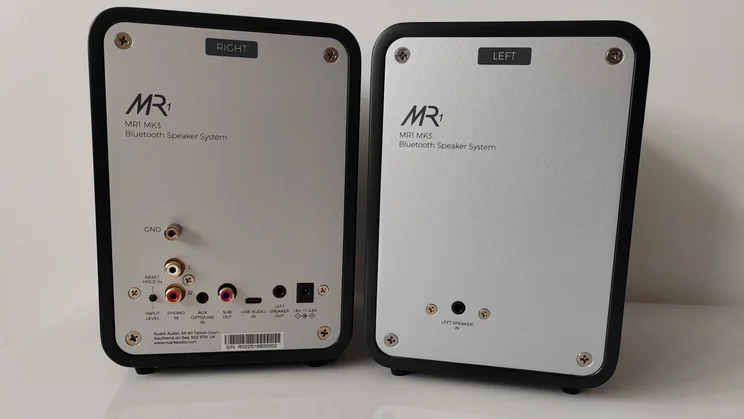

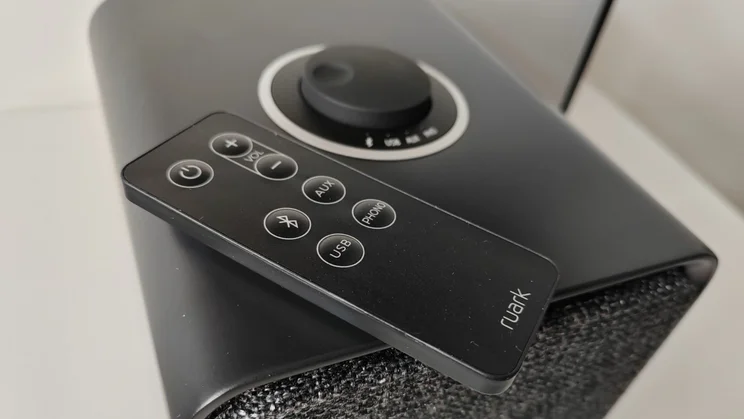
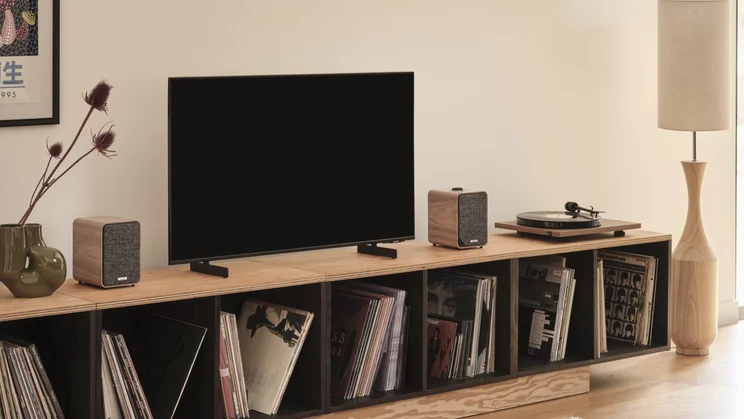
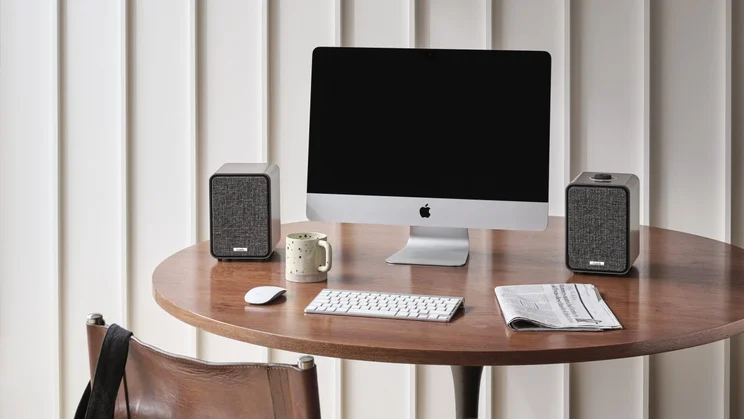
- Excellent audio quality
- Versatile connectivity
- Premium design
- Limited bass depth
- Lacks Wi-Fi
The MR1 Mk3 is the latest generation of Ruark’s award-winning desktop Bluetooth stereo speaker system, first launched in 2013, and last upgraded in 2017.
While its silhouette may look familiar, almost everything inside is new. From a more powerful Class D amplifier to refined drivers and expanded connectivity, this Mk3 iteration is honed for higher-fi, and presented in a package you can easily park on a bookshelf, or even use on a desktop.
Ruark Audio MR1 Mk3: What do you get for the money?
The Ruark MR1 Mk3 are fully active wireless Bluetooth speakers, designed for both streaming sources and wired local kit, be that a vinyl turntable, CD player or media player. As we’ve grown to expect from Ruark, build quality and industrial design is outstanding.
The cabinets have a smooth bevelled edge, a smart charcoal grey fabric grille, and that familiar Ruark RotoDial atop the right-hand unit, which allows you to control volume and switch quickly between inputs.






They’re a reassuringly solid 2.2kg apiece and larger than the Mk2 (135 x 165 x 185mm), but you wouldn’t notice unless someone pedantic pointed it out. My sample came with a charcoal lacquer finish, but there’s also a rich walnut veneer option.
Thanks to Bluetooth 5.1, there’s aptX HD support, alongside SBC and AAC codecs, plus BLE (Bluetooth Low Energy) compliance. A moving magnet phono stage is a rarity in this class, but having plug-and-play compatibility with turntables is a definite bonus.






There’s also a USB-C input for laptops and high-res (96kHz) playback. A digital optical input even makes the MR1 Mk3 a capable TV audio upgrade, although there is no HDMI port, which would make them even more capable.
Everything you need to get up-and-running is in the box. The stereo speaker pair – powered right, passive left – arrive in protective fabric bags, accompanied by a 3m linking cable, power cable, and a dinky, credit-card-style remote control. Ruark also includes a 3.5mm jack-to-optical adapter.
What do they do well?
Less is definitely more with the MR1 Mk3. A triumph of restraint and refinement, this compact sound system delivers its 2 x 25W with remarkable control – and while that level of power output may sound weedy on paper, its execution is as dynamic as heck.
That output comes courtesy of Class D amplification, adapted from Ruark’s larger R410 all-in-one system, and it’s partnered with custom 85mm fibre-cone woofers and 20mm silk-dome tweeters. The result is a soundstage defined by crisp treble, lucid mids, and a tight, rotund bass.
So can a sub-bookshelf design sound truly musical? The proof is in this Ruark pudding.






Diana Krall’s version of “California dreamin'” throws the spotlight on this system’s ability to deliver warm, clean, crisp vocals. There’s nothing cramped or confined here. The MR1s render her performance with warmth and open clarity.
Carole King’s “I Feel the Earth Move”, may be a lot thinner, by dint of the recording’s vintage, but the mid-chorus jam section explodes with energy and instrumental character. The MK3s don’t miss a beat.
Where these speakers really surprise is in their imaging ability. Place the pair on a desk or shelf and they create a coherent, three-dimensional soundstage that extends well beyond physical boundaries.






On Minoru Muraoka’s “Take Five”, his signature shakuhachi flute placed just off-centre, leaving plenty of room for the taiko percussion to solidify.
Similarly, Taylor Swift’s stripped-back “Fortnight (Acoustic Version)” feels intimate and immediate; her voice floats dead-centre.
More challenging cuts, like Billie Eilish’s “Bad Guy”, demonstrate surprising low-end reach. It’s not seismic, yet it is impressively deep from cabinets this compact. If the MR1 MK3 does have an Achilles’ heel, it’s a lack of absolute profundity, but I’m not sure I’d be tempted to take up the option of that subwoofer output, for fear of upsetting the system’s inherent equilibrium. The MK3s are astonishingly well-balanced.
What could be improved?
For all their charm, the MR1 Mk3 are not without limitations. The most obvious is bass depth. Ruark has tuned these small cabinets to sound full-bodied, but sub-bass is muted, so although the MR1 Mk3 duo dig deeper than you might expect, they can’t match the chest-thumping bass of larger bookshelf designs.
If you’re planning on using them as a TV audio replacement, pairing them with Ruark’s RS1 subwoofer would seem a valid investment.






Volume headroom is another consideration. The MR1 Mk3 play loud with considerable confidence, and are easily capable of filling a study or small living room, but they’re not designed for larger spaces. These are nearfield, or modest-sized room speakers, at heart and asking them to power a house party is a bit of stretch.
I’m also not a huge fan of the credit card remote, not least because (for me at least) it’s easily misplaced.
Of course, none of these drawbacks undermine the MR1 Mk3’s essential appeal. Ruark has very much concentrated on sound quality here, and I’m not inclined to criticise.
Ruark Audio MR1 Mk3: Should you buy a pair?
When space is at a premium, but you don’t want to compromise on performance, the Ruark MR1 Mk3 should definitely be on your shortlist.
The system combines genuine Hi-Fi sensibility with everyday convenience, and can perform on a desk, bookshelf, or in a small living room. For music lovers who want quality without clutter, it’s a joy.







